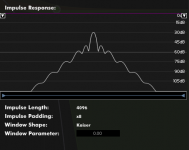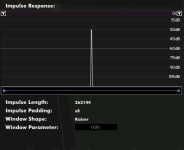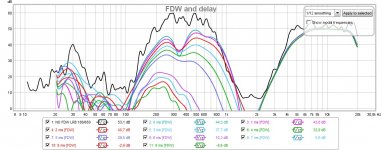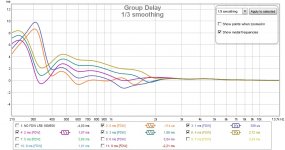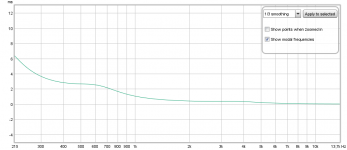I agree with WESAYSO. For low frequency, low tap FIR is not recommended. 262144 is my current impulse length. That's the max number I can do with my computer, but I wish I can make it higher in the future. Digital technology is still very immature. 🙂
what is the shelving or frequency band of that dirac pulse?
thanks
hi guys,
what is the easiest way to import a frequency measurement and a DIFFERENT phase measurement into rephase for eq?
I have a moving mic measurement but it has no phase data obviously. I want to take a single point measurement and use that for phase correction while frequency correcting the moving mic measurement
what is the easiest way to import a frequency measurement and a DIFFERENT phase measurement into rephase for eq?
I have a moving mic measurement but it has no phase data obviously. I want to take a single point measurement and use that for phase correction while frequency correcting the moving mic measurement
hi guys,
what is the easiest way to import a frequency measurement and a DIFFERENT phase measurement into rephase for eq?
I have a moving mic measurement but it has no phase data obviously. I want to take a single point measurement and use that for phase correction while frequency correcting the moving mic measurement
Hi 1201, cut and paste in excel ? as txt (Tab delimited)
hi guys,
what is the easiest way to import a frequency measurement and a DIFFERENT phase measurement into rephase for eq?
With Excel you can open the two measurements, and copy the third
colomn ( with phase data) and paste it in the first ( the mmm measurement )
( had not seen Mark's answer, doublon )
Last edited:
what is the shelving or frequency band of that dirac pulse?
thanks
Those screen shots are from my tweeter side impulse response, cut off @ 600Hz.
Woofer side response (cut off 600 Hz + some bass boost) is this. As you can see, low tap graph shows horrible response.
Attachments
Last edited:
hi guys,
what is the easiest way to import a frequency measurement and a DIFFERENT phase measurement into rephase for eq?
I have a moving mic measurement but it has no phase data obviously. I want to take a single point measurement and use that for phase correction while frequency correcting the moving mic measurement
It might be a good idea to make multiple measurements around a sweet spot and sum them to an average. There's a couple of methods that were discussed in this thread a few pages ago. That would give you phase information without a strong room bias. The averaging of those measurements will lower or rather average the room addition's effect on phase.
Every bump created by a reflection in the IR is where phase response also changes.
If the MMM gives you a good tonal balance, and that single point measurement does not, there's a good chance the influence of the room is the difference between the two. So to get the best picture of phase why not try a similar method.
The discussion started here:
http://www.diyaudio.com/forums/multi-way/221434-rephase-loudspeaker-phase-linearization-eq-fir-filtering-tool-141.html#post4920173
Those screen shots are from my tweeter side impulse response, cut off @ 600Hz.
Woofer side response (cut off 600 Hz + some bass boost) is this. As you can see, low tap graph shows horrible response.
Hi plasnu,
I don't understand what you are showing us...
Are you showing a dirac pulse that has been put through filters, HP, & LP ?
And that doing that with fewer taps gives an impulse horizontally spread out,, ......vs a lot of taps which gives an impulse that is back like a dirac pulse again?
Thanks, I'm having a hard time wrapping my head around what you're showing..🙂
Is anyone have measured the UMC1820 rmaa performance ?
Hi, I downloaded RMAA, thinking why not try it on the umc1820, to be able to give a reply....but it won't open (win10).
I guess I could post some rew measurements if you care...?
Hi plasnu,
I don't understand what you are showing us...
Are you showing a dirac pulse that has been put through filters, HP, & LP ?
And that doing that with fewer taps gives an impulse horizontally spread out,, ......vs a lot of taps which gives an impulse that is back like a dirac pulse again?
Thanks, I'm having a hard time wrapping my head around what you're showing..🙂
Yes, they are the impulse responses generated by EQ software itself, DMG Equilibrium. The first set was is HP, second set is LP. 48dB. Both with some additional EQ points.
https://dmgaudio.com/dl/DMGAudio_EQuilibrium_Manual.pdf
It looks like longer tap gives ideal impulse response, BUT it is not. This plot is scaled to show difference between very low tap and very high tap, so when the plot is zoomed in, I can see the higher tap is still far from ideal.
Question to GURU's. How to setup proper delays?
My 4 ways system LF and MID channels in OFF state, just MB and tweeter is working, delay is changed for MB CH.
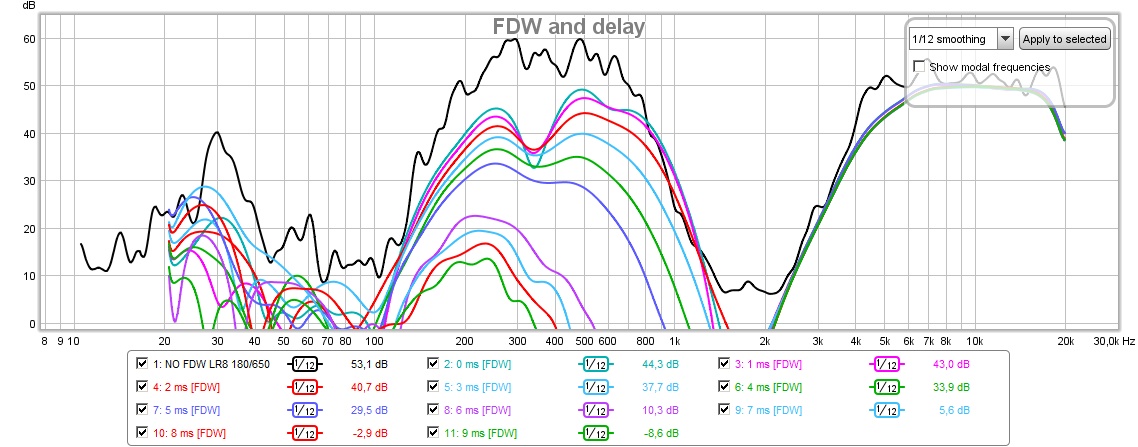
And what hope on 350Hz?
My 4 ways system LF and MID channels in OFF state, just MB and tweeter is working, delay is changed for MB CH.
And what hope on 350Hz?
Attachments
Last edited:
ustas,
Don't count me as guru : ) especially because haven't real world experience for four way system myself, but over time had run so many sims as do I dare to make my bid.
To set up prober delays there is many ways to calibrate, the one you use here with multiple delay settings think would be better if run between TW/MID-MID/MB-MB/LF and at same for each delay setting also reverse polarity for one of the drivers to get deepest as possible null.
What to hope for 350Hz is difficult to say can think of two things making that error, one is you have some active IIR EQ correction right there that is little off probably because based on not so good measurement quality or because microphone spot in space is since changed and second is you have null caused by room and/or drivers position relative to boundary.
Don't count me as guru : ) especially because haven't real world experience for four way system myself, but over time had run so many sims as do I dare to make my bid.
To set up prober delays there is many ways to calibrate, the one you use here with multiple delay settings think would be better if run between TW/MID-MID/MB-MB/LF and at same for each delay setting also reverse polarity for one of the drivers to get deepest as possible null.
What to hope for 350Hz is difficult to say can think of two things making that error, one is you have some active IIR EQ correction right there that is little off probably because based on not so good measurement quality or because microphone spot in space is since changed and second is you have null caused by room and/or drivers position relative to boundary.
Hi 1201, cut and paste in excel ? as txt (Tab delimited)
With Excel you can open the two measurements, and copy the third
colomn ( with phase data) and paste it in the first ( the mmm measurement )
( had not seen Mark's answer, doublon )
thanks guys. I will give that a shot.
It might be a good idea to make multiple measurements around a sweet spot and sum them to an average. There's a couple of methods that were discussed in this thread a few pages ago. That would give you phase information without a strong room bias. The averaging of those measurements will lower or rather average the room addition's effect on phase.
Every bump created by a reflection in the IR is where phase response also changes.
If the MMM gives you a good tonal balance, and that single point measurement does not, there's a good chance the influence of the room is the difference between the two. So to get the best picture of phase why not try a similar method.
The discussion started here:
http://www.diyaudio.com/forums/multi-way/221434-rephase-loudspeaker-phase-linearization-eq-fir-filtering-tool-141.html#post4920173
MMM is pretty much summing to an average except instead of say 9-12 averages people normally do , you have hundreds or thousands in an mmm.
single point measurements are too problematic because if you move the mic even half an inch, the measurement changes. and of course our ears are more than said half inch apart.
if you average the responses, phase is removed. are you saying there is a way to average phase?
Attachments
Question to GURU's. How to setup proper delays?
My 4 ways system LF and MID channels in OFF state, just MB and tweeter is working, delay is changed for MB CH.
And what hope on 350Hz?
most people use the step response measurement to adjust delay
thanks guys. I will give that a shot.
MMM is pretty much summing to an average except instead of say 9-12 averages people normally do , you have hundreds or thousands in an mmm.
single point measurements are too problematic because if you move the mic even half an inch, the measurement changes. and of course our ears are more than said half inch apart.
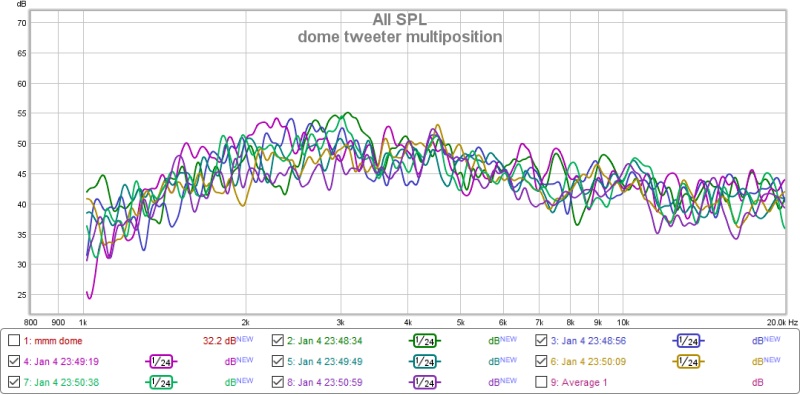
if you average the responses, phase is removed. are you saying there is a way to average phase?
Yes, use the (A+B/2) in pairs in the SPL tab. A bit of work but when done right it will give you an average with phase. See the link I provided.
MMM is a room average. If you fight reflections in a room the MMM would more closely resemble a single measurement at the listening position.
I make it in same way running in real time "Pink PN" and RTA.ustas,
Don't count me as guru : ) especially because haven't real world experience for four way system myself, but over time had run so many sims as do I dare to make my bid.
To set up prober delays there is many ways to calibrate, the one you use here with multiple delay settings think would be better if run between TW/MID-MID/MB-MB/LF and at same for each delay setting also reverse polarity for one of the drivers to get deepest as possible null.
I check all of this again. Thank you.ustas,
What to hope for 350Hz is difficult to say can think of two things making that error, one is you have some active IIR EQ correction right there that is little off probably because based on not so good measurement quality or because microphone spot in space is since changed and second is you have null caused by room and/or drivers position relative to boundary.
Are that can help with setup delays?
REW "Group delay" Overlays tab:
Attachments
Last edited:
Yes, use the (A+B/2) in pairs in the SPL tab. A bit of work but when done right it will give you an average with phase. See the link I provided.
MMM is a room average. If you fight reflections in a room the MMM would more closely resemble a single measurement at the listening position.
hi, when I click the link it just brings me back to the last page of this thread.
maybe you can provide the post number or quote the post again?
THANKS!!!
...Are that can help with setup delays?
REW "Group delay" Overlays tab:
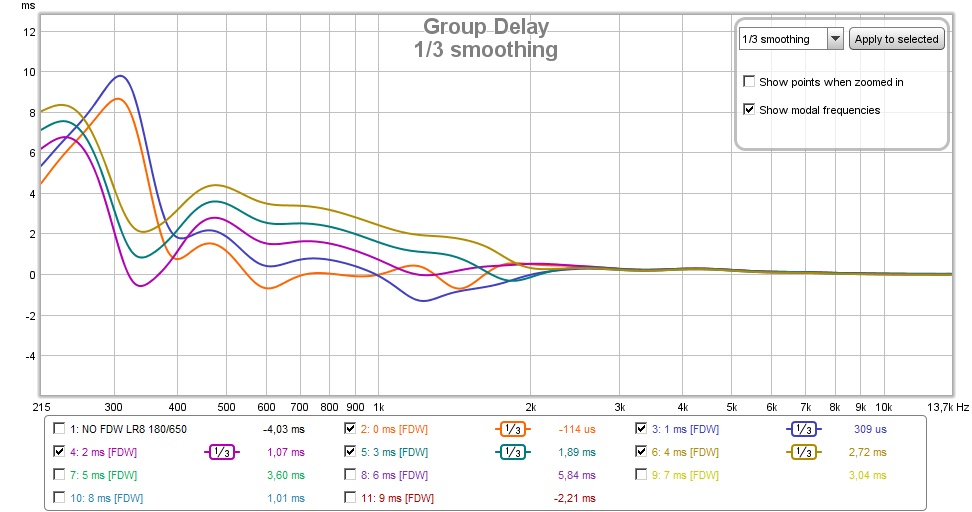
In a way think they can but REW need so much smoothing for "GD" curves to be readable that not sure how to trust for timing drivers acoustic offsets.
For fun did a guess on your band-pass above have MB/MID/TW turned on with LR8 slopes at 180/650/4000Hz and BW2 stop-band at 20kHz, created in Rephase. Importing this IR model to REW show below curve and if we compare it looks your purple and green comes closest, gold is too slow and the ones firing before real-time is too advanced : )
Attachments
hi, when I click the link it just brings me back to the last page of this thread.
maybe you can provide the post number or quote the post again?
THANKS!!!
If below doesn't work too try manual browse for post 1402.
http://www.diyaudio.com/forums/mult...on-eq-fir-filtering-tool-141.html#post4920173
If below doesn't work too try manual browse for post 1402.
http://www.diyaudio.com/forums/mult...on-eq-fir-filtering-tool-141.html#post4920173
Thanks. for some reason the link brought me back to the last page again but this time I just manually went to 1402.
Im reading it now .
thanks 🙂
Ustas, with REW, I use either acoustic or loopback timing references to determine delay.
Usually locates within a few samples. Coming from a smaartlive background, I couldn't imagine going about it any other way 🙂
Biggest problem is always finding subs... I measure raw with the acoustic timing signal jacked up (level can be set independently from measurement levels). Then add group delay figured from electrical xover. Bottom line with subs IMO, is that you just keep varying delay until phase traces overlay.
This is where real time, dual FFT measurements, make life easy.
Usually locates within a few samples. Coming from a smaartlive background, I couldn't imagine going about it any other way 🙂
Biggest problem is always finding subs... I measure raw with the acoustic timing signal jacked up (level can be set independently from measurement levels). Then add group delay figured from electrical xover. Bottom line with subs IMO, is that you just keep varying delay until phase traces overlay.
This is where real time, dual FFT measurements, make life easy.
- Home
- Design & Build
- Software Tools
- rePhase, a loudspeaker phase linearization, EQ and FIR filtering tool
